Perhaps you can spare a little sympathy for the poor soul who has to bring you the results of the new opinion poll from LucidTalk, straight after most US polls failed to pick up the full extent of support for Donald Trump.
Or perhaps you feel that anyone still treating polls seriously deserves all the embarrassment coming their way. (Although you can’t quite resist checking out the results anyway.)
In a way the US experience is a healthy lesson in how to use, and more importantly, not to use the results of opinion polls.
Lesson 1. Don’t forget the margin of error. It’s terribly tempting to assume a poll showing a 1% lead for Party X is telling you that Party X is going to win (especially if you want Party X to win). But it is not saying that. It’s simply telling you that the winner could be Party X, but it could also be their deadly rivals Party Y. The gap between them is smaller than the margin of error.
Lesson 2. Don’t pay attention to outliers. If a poll looks too good or too bad to be true for Party X, then it almost certainly is too good or too bad to be true. (Let’s just say ‘Iowa’ and leave it at that.) Polls are designed to be within the margin of error 95% of the time, but that means that on average 1 in every 20 will be well off.
Lesson 3. Don’t place more trust, or to pay more attention, to the polls which report good results for the party you favour. It could pay to think more about the polls which produce an unwelcome result. Could they be telling you something?
Lesson 4. Don’t ignore the other information that the polls are giving you about public opinion on the key issues, especially the economy.
OK, that’s the ‘don’ts’. There are two key ‘do’s.
Do consider the full range of possible outcomes that the polls could be pointing too.
Do look for trends over time. Polls can give you a good idea of the way that the wind is blowing.
Many might well be genuinely shocked that a person with Trump’s history could be elected, but nobody who followed the polls could really claim to be surprised.
The US polls did show Harris with a lead of more than 3% in the early days of her campaign – the sort of lead the experts were telling us that she would need to overcome the Republican advantage in the Electoral College. But they also showed that lead consistently slipping away over the last few weeks. By the eve of the election her average national lead (as calculated by FiveThirtyEight) was just 1.2%. Well below the margin of error.
The very last poll taken, the only one where surveying continued into the eve of poll, put Trump 1% ahead. (Take a bow AtlasIntel.)
Within the 7 swing states polled support for Harris had also been on a downward trend. By the end the polls showed her behind in 4 of them, while her average leads in the other three were 0.2% (generally considered meaningless in polling term) in Pennsylvania and 1.0% each in Wisconsin and Michigan.
There was just enough there to permit Harris supporters to credibly keep their hopes alive – provided she outperformed the polling figures – but there was also plenty to give them cause for alarm.
Opinion polls don’t tell you what is definitely going to happen, but well-conducted polls do give you informed insight into what might.
You can be sure that the US polling companies will be conducting post-mortems to identify why they failed to pick up the scale of Trump’s victory. And what information will they need to rely on to do that? Why, the exit-polls of course.
With all that in mind let’s take a look at the results of the latest LucidTalk poll in the Belfast Telegraph. This is, of course, measuring current voting intentions for the next Assembly election, due in two and a half years’ time. As such it should not be compared with LT’s polls for the 2024 Westminster election.
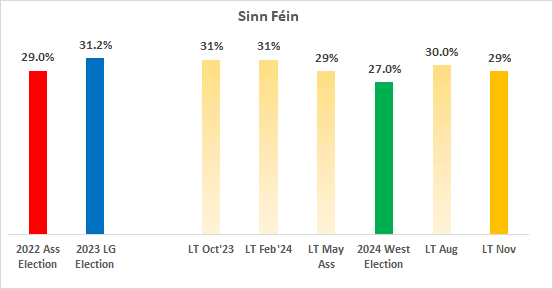
Once again it shows Sinn Féin as the largest party, holding the level of support which brought it to the First Minister position in 2022. On 29% it would be expected to hold all of the seats it won then, apart from its fourth seat in West Belfast which boundary changes look likely to hand to the DUP.
The possibility of gains, held out by the polls for the most of the last two years, is no longer offered by these figures especially when taken together with the showing of the SDLP. In compensation the party’s hold on the FM position actually looks significantly stronger in this poll, as we shall see further down.
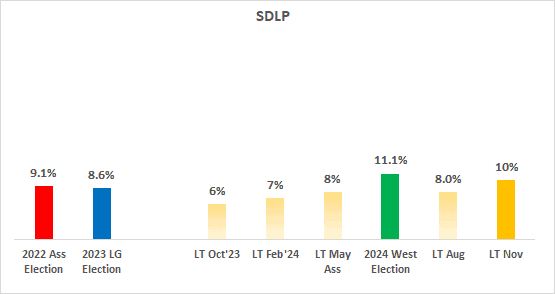

This is the highest level of support for the SDLP recorded by LT in an Assembly poll since before the 2022 election, and it confirms the trend away from the days when the party languished at 6% and 7%. It is unlikely that this level of support would bring the party an additional seat, but it would be expected to lift its most vulnerable current seats out of the reach of SF or Alliance.
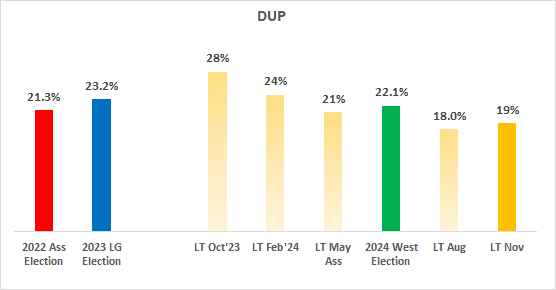

It’s the grim news for the DUP which would confirm SF in the FM post. This despite the fact that the DUP would be favourite for a gain in West Belfast and to retain the additional seat in North Down gifted them by Alex Easton after his election to Westminster.
Because the DUP, down two 2% from the last election would lose seats to the TUV.
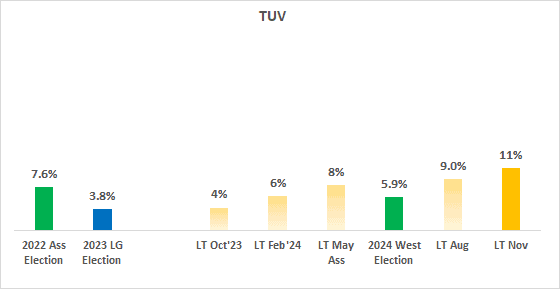

The trend is with the TUV. As a party with relatively even spread of support outside of North Antrim if finds it hard to gain seats below 8% or 9% of the total vote. Its only source of transfers is the DUP, and below that level it simply lacks the strength to knock DUP candidates out of the running. But above that level the balance tips increasingly strongly towards the TUV. There are 8 constituencies where the DUP won a second seat in 2022. A simple calculation shows that if the TUV is taking over a third of the combined DUP/TUV vote it could pick up around half of them.
If it starts getting 12% or 13% the DUP is in very big trouble.
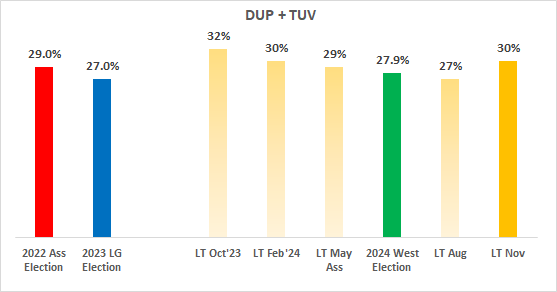

And talking of the combined DUP/TUV vote, that now appears to be polling back where it was before the Donaldson agreement. This is in line with another LucidTalk poll for QUB published last week which showed opinion hardening again against the Windsor Framework. Testing The Temperature 12 | Participation for Protection (P4P) | Queen’s University Belfast
That poll showed 19% of all voters would vote for a candidate who favoured scrapping the Windsor Framework altogether, while a further 12% would support one who wanted to scrap parts of it.
That is hardly surprising. Since Donaldson’s fall no major unionist figure has been defending the Donaldson deal. This leaves the DUP in a bit of a bind. Their leader is strongly associated with the deal and the party wants to remain in Stormont. Yet even Robinson distanced himself and the party somewhat from the deal during the recent Westminster election campaign. If the DUP criticise the trading arrangements, they play to the TUV’s strength as its most committed opponent. If they don’t criticise it, they put themselves out of step with the sentiment of most unionist voters.
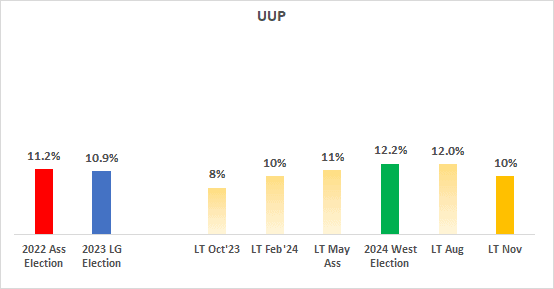

It appears possible that the hardening of unionist opposition to the Windsor Framework might to harming the UUP, and a drop to 10% in an election could put a seat at risk. Or it could simply be statistical variation. We shall need to see future polls since the party’s polling level has varied a bit over the last year.


We will also need to keep an eye on future Alliance polling. In the last Assembly election it took a number of seats with narrow margins. Obviously, it would prefer to go into the next election with the cushion that its 15% level on recent polls suggested.
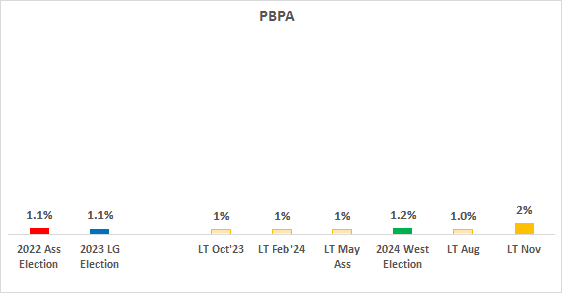

If it achieves this in the next election its West Belfast seat should be safe.
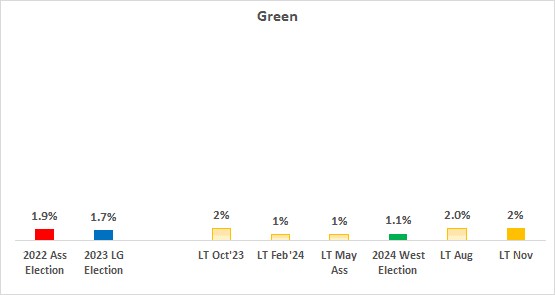

The Green vote is not sufficiently geographically concentrated to give it much prospect of a seat at this level of support.
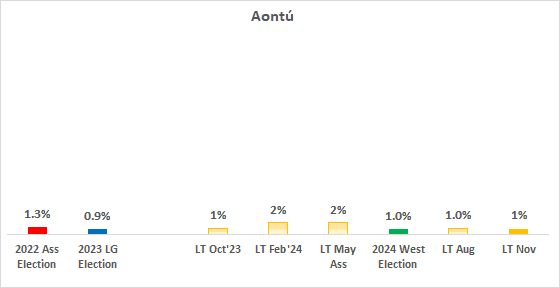

You can read reports on the other topics in the LucidTalk poll in the Telegraph today and tomorrow.
Michael Hehir is a retired sales and marketing manager. He studied in Northern Ireland but now lives between England and Italy.
Discover more from Slugger O’Toole
Subscribe to get the latest posts sent to your email.



